The Implementation Path for a Policy Balancing Cultivated Land Occupation and Reclamation Based on Land-Type Classification—A Case Study in Heilongjiang Province
Abstract
1. Introduction
2. Theoretical Framework
2.1. Land-Type Classification at the Provincial Level
2.2. Agricultural Land Potential Productivity Evaluation Based on Land Types
2.3. Theoretical Thoughts on the Implementation of a Policy for Balancing Cultivated Land Occupation and Reclamation
3. Materials and Methods
3.1. Study Area
3.2. Methods
3.2.1. Land-Type Classification
3.2.2. Evaluation Method System of Agricultural Land Potential Productivity
3.2.3. The Implementation Paths of Balancing Cultivated Land Occupation and Reclamation Policy
3.3. Data Source and Process
4. Results
4.1. The Results of Land-Type Classification in Heilongjiang Province
4.2. The Evaluation Results of Agricultural Potential Productivity
4.2.1. Climate Potential Productivity
4.2.2. Agricultural Potential Productivity
4.2.3. Agricultural Potential Productivity Grade Zoning
4.3. Optimal Scheme for Balancing Cultivated Land Occupation and Reclamation
5. Discussion
5.1. Analysis of Agricultural Potential Productivity of Different Land Types
5.2. Policy Implications for Balancing Cultivated Land Occupation and Reclamation
5.3. Innovation, Limitations, and Prospects for Future Studies
6. Conclusions
Author Contributions
Funding
Institutional Review Board Statement
Data Availability Statement
Acknowledgments
Conflicts of Interest
References
- Han, H.B.; Zhang, X.Y. Exploring environmental efficiency and total factor productivity of cultivated land use in China. Sci. Total Environ. 2020, 726, 138434. [Google Scholar] [CrossRef] [PubMed]
- Liu, J.J.; Zhong, X.P. The practice, problems and improvement strategies of China’s food security emergency guarantee mechanism: A case study of Henan rainstorm disaster response. Issues Agric. Econ. 2024, 7, 34–47. [Google Scholar]
- Fei, R.; Lin, Z.; Chunga, J. How land transfer affects agricultural land use efficiency: Evidence from China’s agricultural sector. Land Use Policy 2021, 103, 105300. [Google Scholar] [CrossRef]
- Long, H.L.; Kong, X.B.; Hu, S.G.; Li, Y.R. Land use transitions under rapid urbanization: A perspective from developing China. Land 2021, 10, 935. [Google Scholar] [CrossRef]
- Wang, M.M.; Jiang, Z.Z.; Li, T.B.; Yang, Y.C.; Jia, Z. Analysis on absolute conflict and relative conflict of land use in Xining metropolitan area under different scenarios in 2030 by PLUS and PFCI. Cities 2023, 137, 104314. [Google Scholar]
- Yan, H.T.; Chen, H.; Wang, F.; Qiu, L.J.; Li, R. Early warning and management measures for the non-agriculturalization of cultivated land in Shaanxi Province of China based on a patch-generated land use simulation Model. Agriculture 2025, 15, 672. [Google Scholar] [CrossRef]
- Li, Y.H.; Li, Y.R.; Westlund, H.; Liu, Y.S. Urban-rural transformation in relation to cultivated land conversion in China: Implications for optimizing land use and balanced regional development. Land Use Policy 2015, 47, 218–224. [Google Scholar] [CrossRef]
- Kong, X.B. Transition objectives, contents and ways of cultivated land protection in China under the background of rehabilitation system. J. Soc. Sci. Hunan Normal Univ. 2021, 50, 1–12. [Google Scholar]
- Hossain, A.; Krupnik, T.J.; Timsina, J.; Mahboob, M.G.; Chaki, A.K.; Farooq, M.; Bhatt, R.; Fahad, S.; Hasanuzzaman, M. Agricultural land degradation: Processes and problems undermining future food security. In Environment, Climate, Plant and Vegetation Growth; Fahad, S., Hasanuzzaman, M., Alam, M., Ullah, H., Saeed, M., Khan, I.A., Adnan, M., Eds.; Springer: Cham, Switzerland, 2020. [Google Scholar]
- Luo, X.L.; Yang, R.; Xu, Q. Spatial mismatch evolution of global population and food and its influencing factors. J. Nat. Resour. 2021, 36, 1381–1397. [Google Scholar] [CrossRef]
- Hu, Q.; Wu, W.B.; Xiang, M.T.; Chen, D.; Long, Y.Q.; Song, Q.; Liu, Y.Z.; Lu, M.; Yu, Q.Y. Spatio-temporal changes in global cultivated land over 2000–2010. Sci. Agric. Sin. 2018, 51, 1091–1105. [Google Scholar]
- Chen, G.Z.; Li, X.; Liu, X.P.; Chen, Y.M.; Liang, Y.; Leng, J.Y.; Xu, X.C.; Liao, W.L.; Qiu, Y.A.; Wu, Q.L.; et al. Global projections of future urban land expansion under shared socioeconomic pathways. Nat. Commun. 2020, 11, 537. [Google Scholar] [CrossRef] [PubMed]
- Li, H.H.; Song, W. Spatial transformation of changes in global cultivated land. Sci. Total Environ. 2023, 859, 160194. [Google Scholar] [CrossRef]
- Liu, Y.; Fang, F.; Li, Y. Key issues of land use in China and implications for policy making. Land Use Policy 2014, 40, 6–12. [Google Scholar] [CrossRef]
- Huang, W.J. An analysis on the implementation path of cultivated land “access-exit balance” policy. Res. Guide 2022, 6, 20. [Google Scholar]
- Liang, K.Y.; Jin, X.B.; Wang, S.L.; Ying, S.C.; Qi, Z.; Zhou, Y.K. Control of balancing cultivated land conversion by integrating “homogeneous equivalence” and “loss-supplement balance”: Methodology and empirical study. China Land Sci. 2023, 37, 77–88. [Google Scholar]
- Su, Y.; Qian, K.; Lin, L.; Wang, K.; Guan, T.; Gan, M.Y. Identifying the driving forces of non-grain production expansion in rural China and its implications for policies on cultivated land protection. Land Use Policy 2020, 92, 104435. [Google Scholar] [CrossRef]
- Song, M.; Peng, J.Y.; Yi, L.P.; Fu, J.H. Quantity and quality balance of farmland in Hubei Province in the context of compensation for comprehensive occupation and its impact on grain production capacity. China Popular. Resour. Environ. 2024, 34, l173–186. [Google Scholar]
- Wang, Y.; Zeng, X.; Liu, Z.Y.; Dong, S.Z.; Jiang, Y.T. Determinants of the spatiotemporal differentiation of cultivated land non-grain conversion in Liaoning Province: The role of multiple stakeholder decisions. Res. Sci. 2023, 45, 980–993. [Google Scholar] [CrossRef]
- Foley, J.A.; Ramankutty, N.; Brauman, K.A.; Cassidy, E.S.; Gerber, J.S.; Johnston, M.; Mueller, N.D.; O’Connell, C.; Ray, D.K.; West, P.C.; et al. Solutions for a cultivated planet. Nat. Int. Weekly J. Sci. 2011, 478, 337–342. [Google Scholar] [CrossRef]
- Li, F.P.; Liu, W.; Lu, Z.B.; Mao, L.C.; Xiao, Y.H. A multi-criteria evaluation system for arable land resource assessment. Environ. Monit. Assess. 2020, 192, 79. [Google Scholar] [CrossRef]
- Wang, W.M. Historical review and prospect of land science discipline construction in China. China Land Sci. 2001, 15, 22–27. [Google Scholar]
- Shen, Y.C. Studies on land types: Academic significance function and prospect. Geogr. Res. 2010, 29, 575–583. [Google Scholar]
- Bourne, R. Regional survey and its relation to stocktaking of the agricultural and forest resources of the British Empire. Geogr. J. 1932, 79, 341. [Google Scholar]
- Christian, C.S.; Stewart, G.A. Methodology of integrated surveys: Aerial surveys and integrated surveys. In Proceedings of the Touluase Conference, UNESCO, Paris, France, 30 October 1968. [Google Scholar]
- Zonneveld, I.S. Land Evaluation and Land (Scape) Science. ITC Textbook of Photo-Interpretation; ITC: Enschede, The Netherlands, 1979. [Google Scholar]
- Cleland, D.T.; Avers, P.E.; McNab, W.H.; Jensen, M.E. National hierarchical framework of ecological units. In Ecosystem Management Applications for Sustainable Forest and Wildlife Resources; Boyce, M.S., Haney, A., Eds.; Yale University Press: New Haven, CT, USA, 1997; pp. 181–200. [Google Scholar]
- NRCS. Land Resource Regions and Major Land Resource Areas of the United States, the Caribbean, and the Pacific Basin; NRCS Agricultural Handbook 296; USDA: Washington, DC, USA, 2006. [Google Scholar]
- Salley, S.W.; Curtis, M.H.; Brown, J.R. Completing the land resource hierarchy. Rangelands 2016, 38, 313–317. [Google Scholar] [CrossRef][Green Version]
- Canada Statistics. National Ecological Framework for Canada; Research Branch Agriculture and Agri-Food Canada: Ottawa, ON, Canada, 2017; ISBN 978-0-660-24501-0. [Google Scholar]
- Zhao, S.Q.; Shen, Y.C. The land classification system (draft) of 1/1 million and 1/200,000 land type maps of key provinces (autonomous regions) in China. Nat. Resour. 1980, 3, 13–24. [Google Scholar]
- Bailey, R.G. Ecoregions Map of North America: Explanatory Note: US Department of Agriculture; USDA Forest Service: Washington, DC, USA, 1998. [Google Scholar]
- Capotorti, G.; Guida, D.; Siervo, V.; Smiraglia, D.; Blasi, C. Ecological classification of land and conservation of biodiversity at the national level: The case of Italy. Biol. Conserv. 2012, 147, 174–183. [Google Scholar] [CrossRef]
- Bestelmeyer, B.T.; Tugel, A.J.; Peacock, G.L., Jr.; Robinett, D.G.; Shaver, P.L.; Brown, J.R.; Herrick, J.E.; Sanchez, H.; Havstad, K.M. State-and-transition models for heterogeneous landscapes: A strategy for development and application. Rangeland Ecol. Manag. 2009, 62, 1–15. [Google Scholar] [CrossRef]
- Grondin, P.; Gauthier, S.; Borcard, D.; Bergeron, Y.; Noël, J. A new approach to ecological land classification for the Canadian boreal forest that integrates disturbances. Landsc. Ecol. 2014, 29, 1–16. [Google Scholar] [CrossRef]
- Lü, Y.H.; Hu, J.; Fu, B.J.; Harris, P.; Wu, L.H.; Tong, X.L.; Bai, Y.F.; Comber, A.J. A framework for the regional critical zone classification: The case of the Chinese Loess Plateau. Nati. Sci. Rev. 2019, 6, 14–18. [Google Scholar] [CrossRef]
- Zhang, G.H.; Song, X.D.; Wu, K.N. A classification scheme for Earth’s critical zones and its application in China. Sci. China Earth Sci. 2021, 51, 1681–1692. [Google Scholar] [CrossRef]
- Batchelor, W.D.; Basso, B.; Paz, J.O. Examples of strategies to analyze spatial and temporal yield variability using crop models. Eur. J. Agron. 2002, 18, 141–158. [Google Scholar] [CrossRef]
- Van Ittersum, M.K.; Leffelaar, P.A.; van Keulen, H.; Kropff, M.J.; Bastiaans, L.; Goudriaan, J. On approaches and applications of the Wageningen crop models. Eur. J. Agron. 2003, 18, 201–234. [Google Scholar] [CrossRef]
- Xie, J.Q.; Cai, Y.M.; Zheng, Z.Y.; Lin, P. AEZ-based assessment for food productivity potential of cultivated land in China. China Land Sci. 2004, 18, 31–37. [Google Scholar]
- Gao, W.B.; Jiang, D.; Yang, X.H. Cultivated land potential production model and application driven by RS information. Prog. Geog. 2009, 28, 119–124. [Google Scholar]
- Li, X.L.; Wu, K.N.; Chu, X.X.; Yang, Q.J.; Zhang, X.D.; Hao, S.H. Research progress and prospects for cultivated land productivity evaluation. China Land Sci. 2019, 33, 91–100. [Google Scholar]
- Liu, L.M.; Zhou, D.; Chang, X.; Lin, Z.L. A new grading system for evaluating China’s cultivated land quality. Land Degrad. Dev. 2020, 31, 1482–1501. [Google Scholar] [CrossRef]
- Yang, S.L.; Bai, Y.; Alatlo, J.M.; Wang, H.M.; Tong, J.P.; Liu, G.; Zhang, F.; Chen, J.Y. Spatial–temporal pattern of cultivated land productivity based on net primary productivity and analysis of influencing factors in the Songhua River basin. Land Degrad. Dev. 2022, 33, 1917–1932. [Google Scholar] [CrossRef]
- Turner, B.L.; Meyer, W.B. Land use and land cover in global environmental change: Considerations for study. Int. Soc. Sci. J. 1991, 43, 669. [Google Scholar]
- Yang, S.H.; Zhang, G.L. What is the Critical Zone? Sci. News 2021, 73, 33–36+4. [Google Scholar]
- Naylor, L.A.; Dungait, J.A.J.; Zheng, Y.; Buckerfield, S.; Green, S.M.; Oliver, D.M.; Liu, H.Y.; Peng, J.; Tu, C.L.; Zhang, G.L.; et al. Achieving sustainable earth futures in the Anthropocene by including local communities in critical zone science. Earth’s Future 2023, 11, e2022EF003448. [Google Scholar] [CrossRef]
- Qiu, B.J. Mr. Kezhen Zhu and China’ s climatic zone. J. Southwest Techers Univ. 1986, 3, 79–84. [Google Scholar]
- Li, Z.; Zhang, M.L.; Zhang, Y.C.; Lin, C.W.; Zheng, J.L.; Wang, S.T.; Zhou, Y.P. Landscape pattern characteristics of mountain land types–taking the Fuping County, Hebei Province as an example. For. Ecol. Sci. 2021, 36, 254–261. [Google Scholar]
- Guan, L.Z. General Soil Science; China Agriculture Press: Beijing, China, 2016. [Google Scholar]
- Bredehoeft, J.D.; Papadopulos, S.S.; Cooper, H.H., Jr. Scientific Basis of Water Resources Management; National Academy Press: Washington, DC, USA, 1982. [Google Scholar]
- Liu, Y.N.; Wu, K.N.; Li, X.L.; Li, X. Land-type classification at provincial level based on GIS and Fuzzy SOFM Model: A case study of Henan Province. China Land Sci. 2021, 35, 112–122. [Google Scholar]
- Ni, S.X. Introduction to Land Types and Land Evaluation, 3rd ed.; Higher Education Press: Beijing, China, 2009. [Google Scholar]
- Zhu, H.Z.; Wang, J.L.; Zhong, H.P.; Zhou, L.L.; Yang, H.; Liu, Q. Concept of building multi-level classification system framework for land type based on grid. J. Geo-Inf. Sci. 2015, 17, 783–788. [Google Scholar]
- Li, D.; Wang, S.; Zhou, J.; Qiao, W.H.; Song, Y.J. Spatial pattern evolution characteristics of cultivated land conversion in Heilongjiang province. J. Nat. Sci. Hunan Normal Univ. 2022, 45, 81–89. [Google Scholar]
- Zaks, D.P.M.; Ramankutty, N.; Barford, C.C.; Foley, J.A. From Miami to Madison: Investigating the relationship between climate and terrestrial net primary production: Climatic controls of NPP. Glo. Biogeochem. Cycles 2007, 21, GB3004. [Google Scholar]
- Xu, Y.Q.; Zhou, B.T.; Yu, L.; Xu, Y. Climatic potential productivity and population carrying capacity in China from 1961 to 2010. J. Meteorol. Environ. 2019, 35, 84–91. [Google Scholar]
- Kong, X.B. Practice of Regional Cultivated Land Quantity Control and Quality Improvement; Science Press: Beijing, China, 2014. [Google Scholar]
- Wu, Q.T. Environmental Soil Science; China Agricultural Press: Beijing, China, 2015. [Google Scholar]
- Makovníková, J.; Širáň, M.; Houšková, B.; Pálka, B.; Jones, A. Comparison of different models for predicting soil bulk density. Case study–Slovakian agricultural soils. Int. Agrophys. 2017, 31, 491–498. [Google Scholar] [CrossRef]
- Stiglitz, R.Y.; Mikhailova, E.A.; Sharp, J.L.; Post, C.J.; Schlautman, M.A.; Gerard, P.D.; Cope, M.P. Predicting soil organic carbon and total nitrogen at the farm scale using quantitative color sensor measurements. Agronomy 2018, 8, 212. [Google Scholar] [CrossRef]
- TD/T 1055—2019; Technical Regulation of the Third Nationwide Land Survey. Standards Press of China: Beijing, China, 2019.
- GB/T 28407—2012; Regulation for Gradation on Agriculture Land Quality. Standards Press of China: Beijing, China, 2012.
- NY/T 1634—2008; Rules for Soil Quality Survey and Assessment. Standards Press of China: Beijing, China, 2008.
- SL 190—2007; Standards for Classification and Gradation of Soil Erosion. Standards Press of China: Beijing, China, 2007.
- GB/T33469—2016; Cultivated Land Quality Grade. Standards Press of China: Beijing, China, 2016.
- Zheng, J.Y.; Bian, J.J.; Ge, Q.S.; Hao, Z.X.; Yi, Y.H.; Liao, Y.M. The climate regionalization in China for 1981–2010. Chinese Sci. Bull. 2013, 58, 3088–3099. [Google Scholar]
- Zhou, C.H.; Cheng, W.M.; Qian, J.K.; Li, B.Y.; Zhang, B.P. Research on the classification system of digital land geomorphology of 1:1000000 in China. J. Geo-Inf. Sci. 2009, 11, 707–724. [Google Scholar]
- Fu, J. The key and difficult points and suggestions for the work of cultivated land “access-exit balance”. Rural Sci. Technol. 2022, 3, 31–34. [Google Scholar]
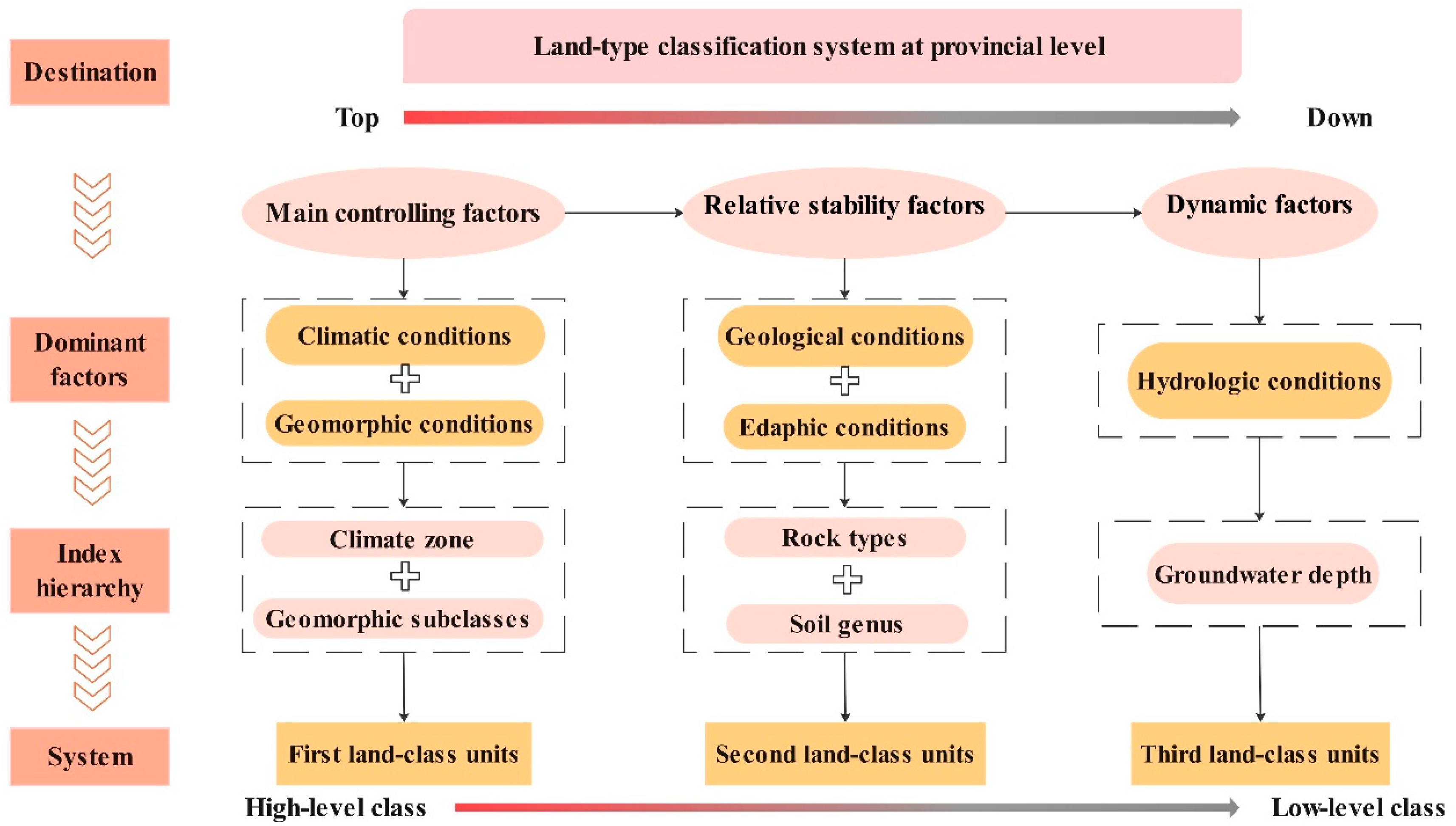
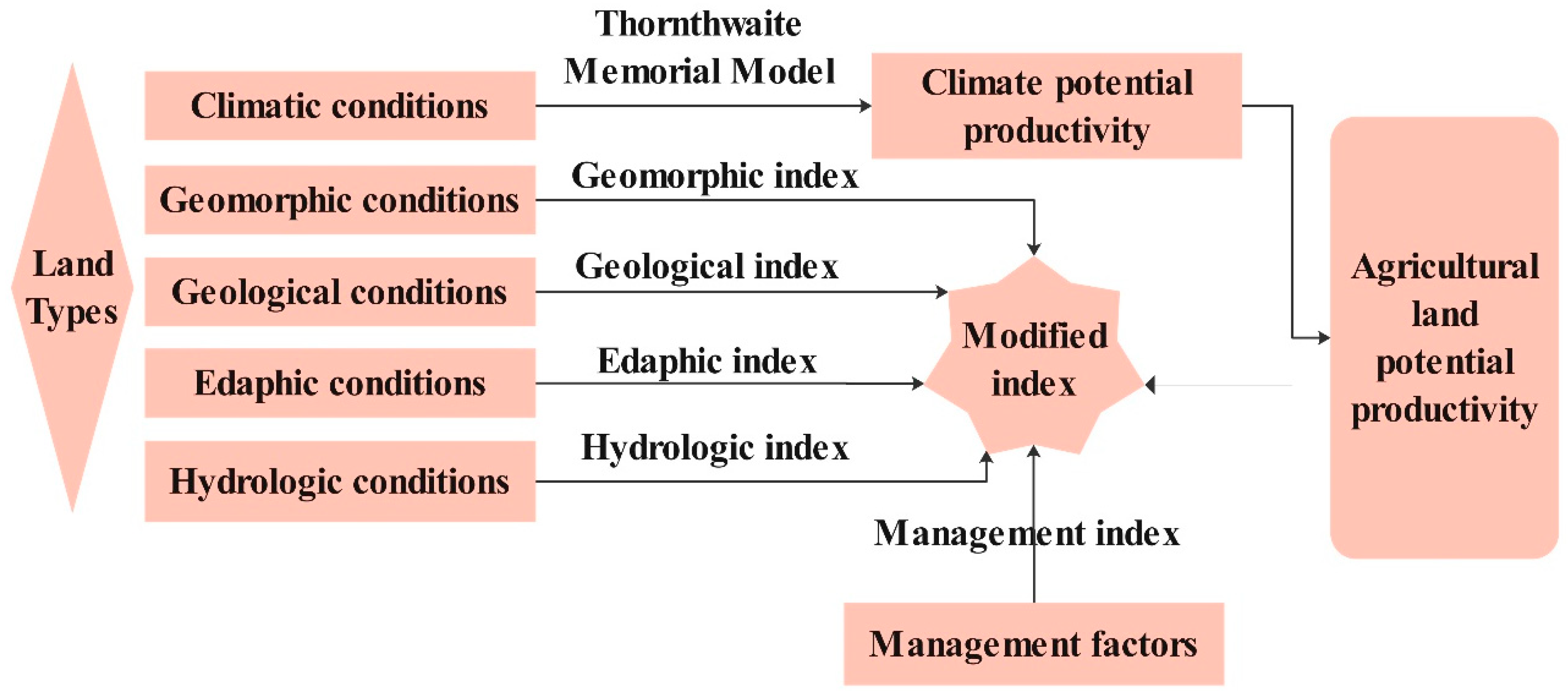
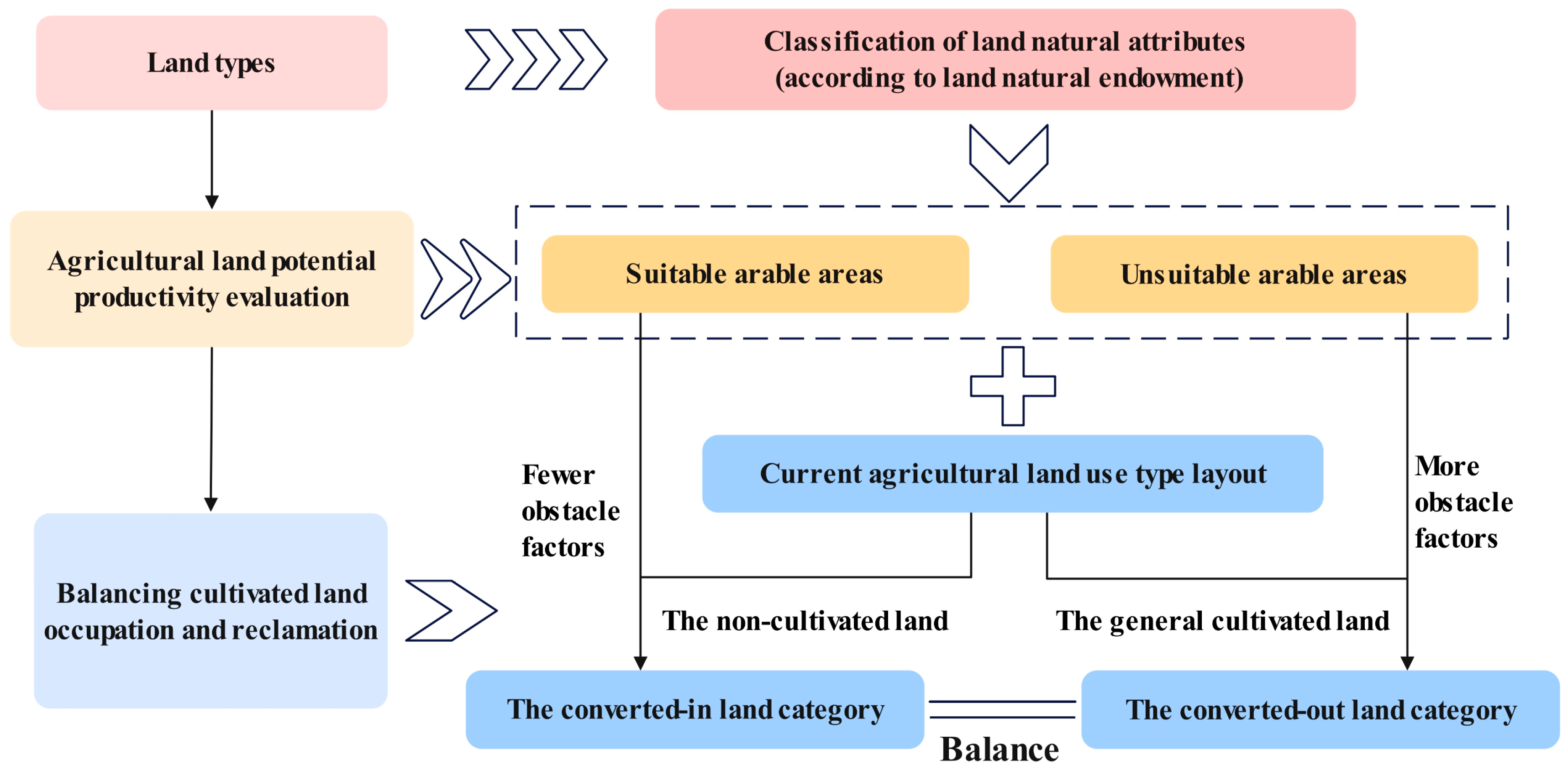
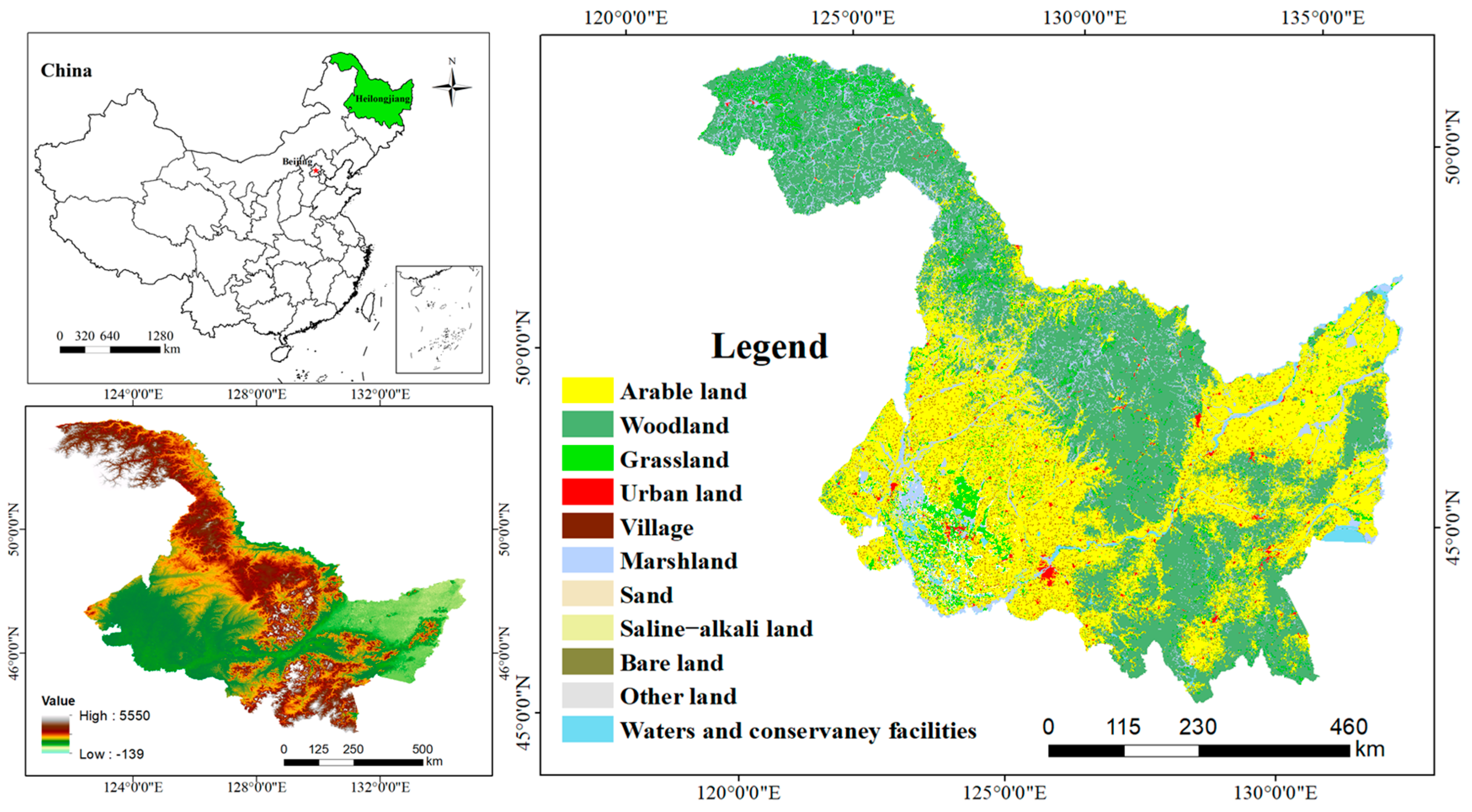
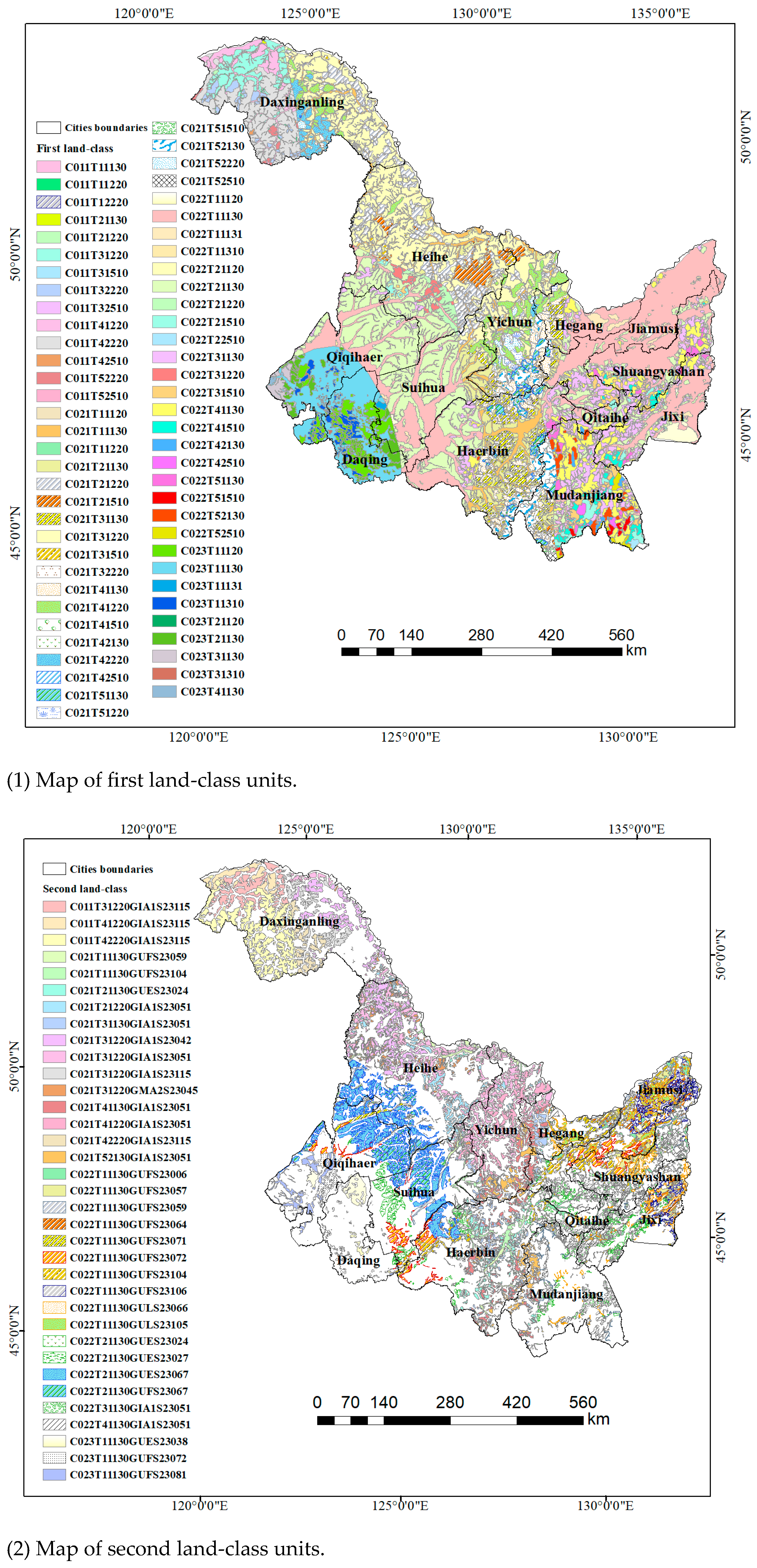

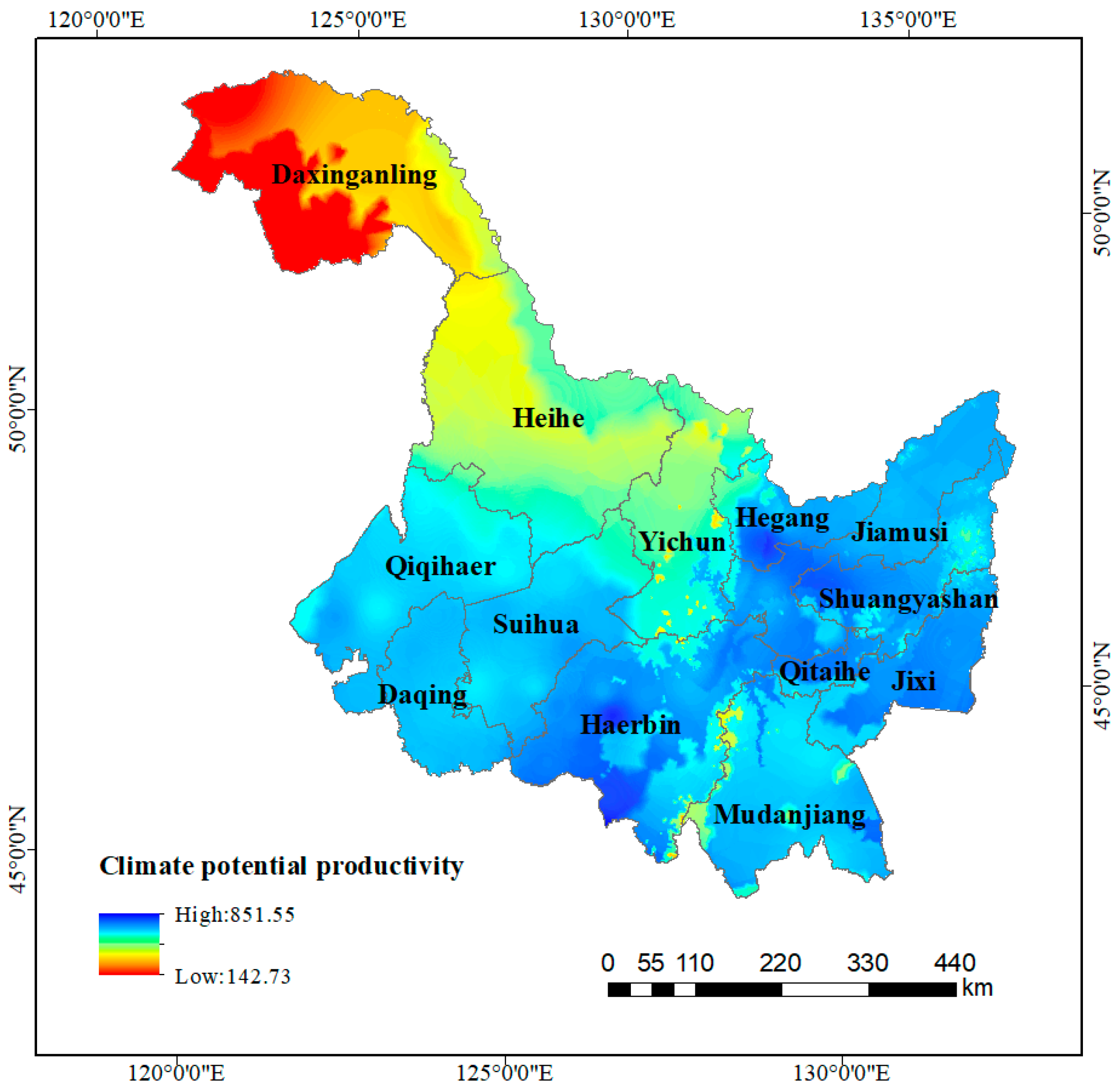
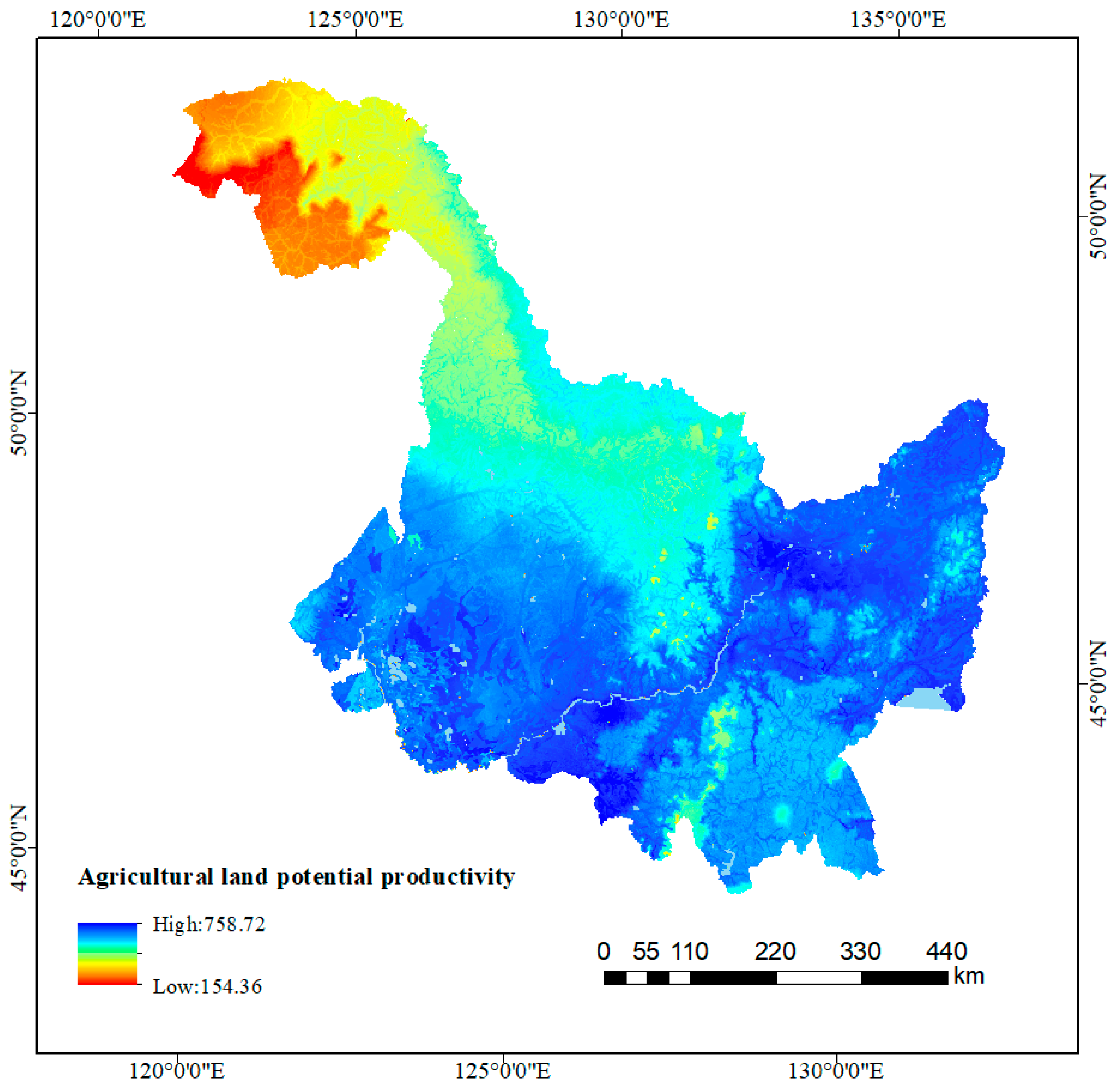
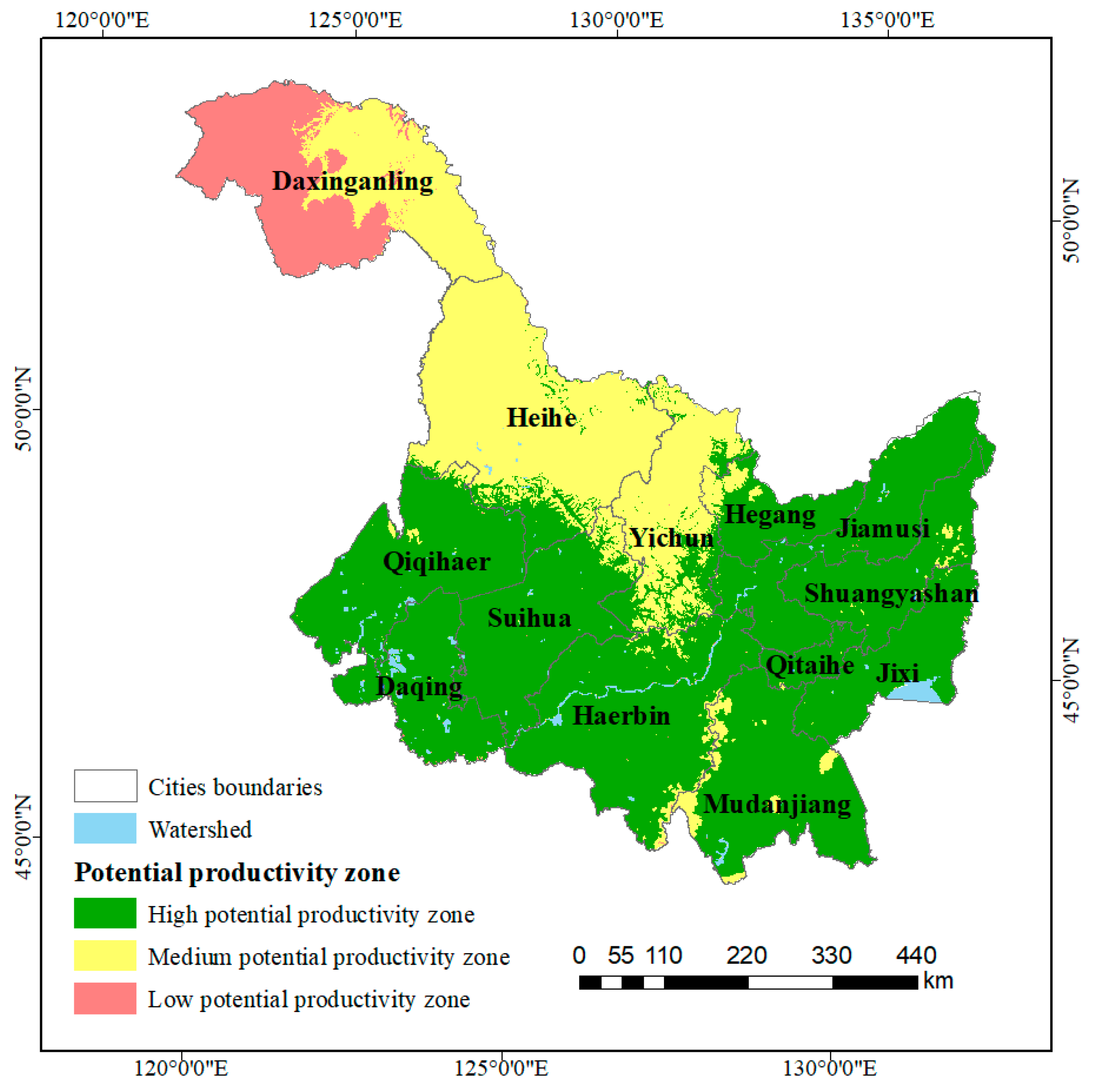
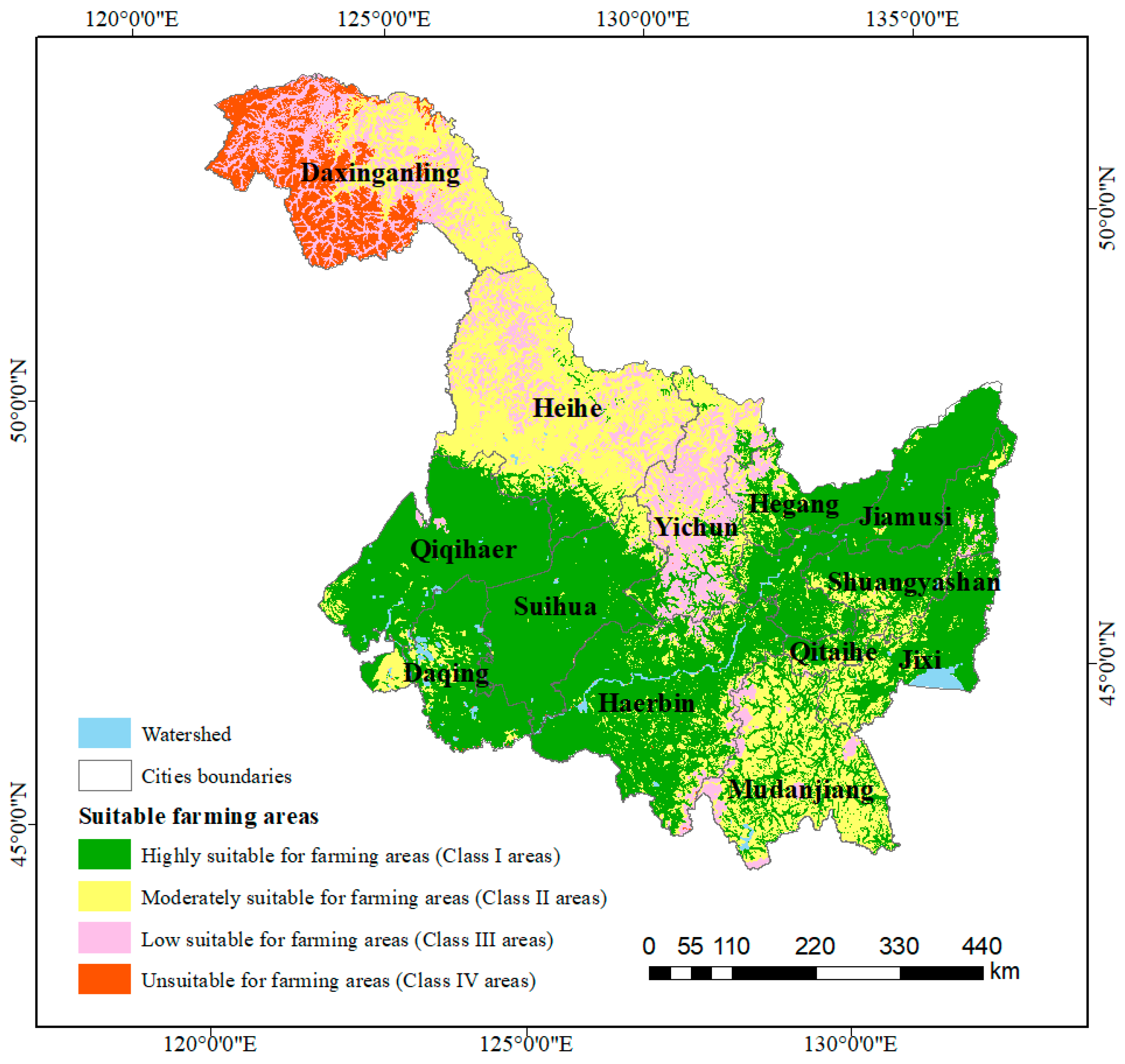
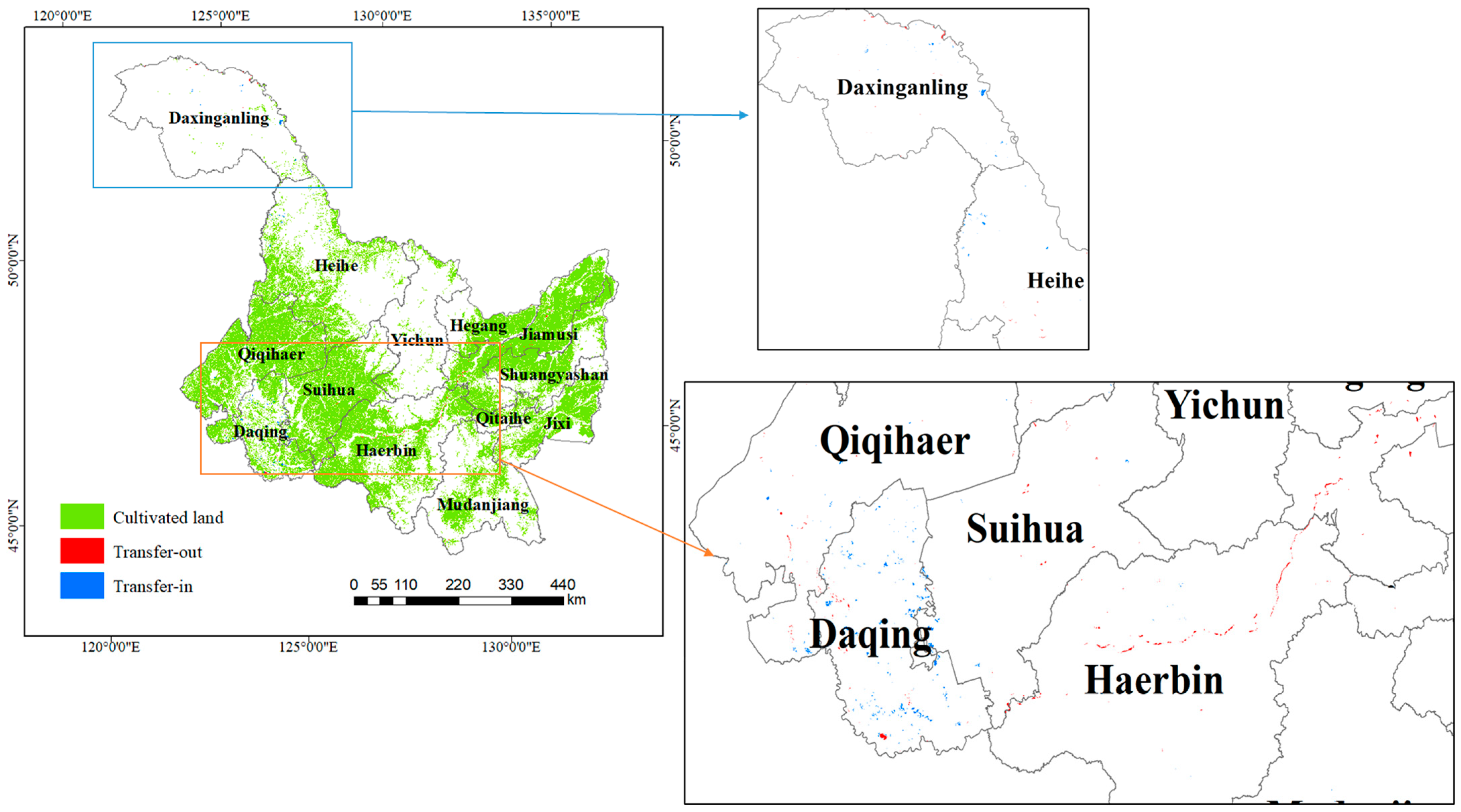
| Factors | Indices | Grading Standard | Weight | |||||
|---|---|---|---|---|---|---|---|---|
| 100 | 90 | 80 | 70 | 60 | 25 | |||
| Topography | Surface morphology | Plain | Platform | Hill | Small rolling hills | The rolling hills | Great Rolling Hills | 0.0251 |
| Slope/° | <2 | 2~6 | 6~15 | 15~25 | ≥25 | 0.0875 | ||
| Altitude/m | <100 | 100~300 | 300~500 | 500~800 | 800~1500 | ≥1500 | 0.0378 | |
| Geological condition | Rock types | Loose sediments: alluvial deposits, lacustrine deposits and marine deposits, etc. | Rocks rich in syenite: granite, syenite, rhyolite, feldspar sandstone, gneiss, etc. | Rocks rich in dark minerals: gabbro, basalt, diorite, andesite, etc. | Rocks containing CaCO3: limestone, marble, marl, dolomitic limestone, calcareous sandstone, shale, etc. | High SiO2 content of rocks: quartzite, quartz sandstone, shale, etc. | 0.0185 | |
| Edaphic condition | Soil texture | Loam | Clay | Sand | Gravelly soil | 0.1052 | ||
| Soil thickness/cm | ≥150 | 100~150 | 60~100 | 30~60 | <30 | 0.0540 | ||
| Soil organic carbon/% | ≥2.0 | 2.0~1.2 | 1.2~0.6 | 0.6~0.2 | 0.1~0.2 | <0.1 | 0.1203 | |
| Gravel content/% | ≤2 | 2~5 | 5~8 | 8~11 | 11~15 | >15 | 0.0316 | |
| Bulk density/g·cm−3 | 1~1.25 | 1.25~1.35 | 1.35~1.45 | 1.45~1.55 | ≥1.55 or <1 | 0.0855 | ||
| Soil pH | 6.5~7.5 | 5.0~6.5 or 7.5~8.5 | 4.0~5.0 or 8.5~9.5 | ≥9.0 or <4.0 | 0.0722 | |||
| Edaphic condition | Soil available water content/% | 150 | 125 | 100 | 75 | 50 | 15 | 0.1085 |
| Cation exchange capacity/cmol·kg−1 | >20 | 15~20 | 10~15 | 6~10 | 3~6 | ≤3 | 0.0258 | |
| Base saturation/% | 55~70 | 40~55 or 70~80 | 10~40 or 80~90 | ≥90 or ≤10 | 0.0195 | |||
| Soil erosion degree | Micro | Mild | Moderate | Severe | Extremely severe | 0.0723 | ||
| Hydrologic condition | Groundwater depth/m | >20 | 5~20 | 0~5 | 0.0422 | |||
| Management factors | Irrigationcondition | Full | Basic | General | Little | 0.0478 | ||
| Drainage condition | Fine | Good | Normal | Worse | Severe | 0.0462 | ||
| Zoning Scheme | High Potential Productivity Zone | Medium Potential Productivity Zone | Low Potential Productivity Zone | |
|---|---|---|---|---|
| Correction index | ≥85 | I | II | III |
| [75,85) | II | III | IV | |
| [60,75) | II | III | IV | |
| <60 | IV | |||
| Data Type | Data Description | Data Source | |
|---|---|---|---|
| Land-type classification data | Climate zone | China’s climate zone map from 1981 to 2010 [67] | |
| Geomorphic subclasses | China’s digital land geomorphology (1:1 million) [68] | ||
| Rock types | World Soils and Terrain Digital Database (SOTER) | National Earth System Science Data Center (http://www.geodata.cn/, accessed on 15 December 2023) | |
| Soil genus | Soil type data of Henan Province (1:2,000,000) | ||
| Groundwater depth | Water Related Knowledge Service System (http://mwr.ckcest.cn/, accessed on 28 March 2024) | ||
| Agricultural land potential productivity evaluation index basic data | Annual average temperature, annual average precipitation | China Meteorological Data Service Centre (http://data.cma.cn, accessed on 10 May 2024) | |
| Slope and altitude | Geospatial Data Cloud (https://www.gscloud.cn/, accessed on 10 May 2024) (DEM: 30 m) | ||
| Soil texture, soil thickness, soil organic carbon, soil available water content, base saturation | Harmonized World Soil Database (HWSD v1.2) (1 km) | ||
| Gravel content, bulk density, cation exchange capacity, soil pH | SoilGrids data (https://soilgrids.org/, accessed on 15 May 2024) | ||
| Soil erosion degree | Chinese Academy of Sciences Resource and Environment Science and Data Center (https://www.resdc.cn, accessed on 20 May 2024) | ||
| Irrigation and drainage conditions | The buffer zone is established based on the waterhead and calculated by referring to the compilation of statistical yearbooks | ||
| Land-use status data | Land use remote sensing monitoring data (30 m) | Chinese Academy of Sciences Resource and Environment Science and Data Center | |
| ID | Name | Area Proportion (%) | Potential Productivity Value (g/(m2·a) |
|---|---|---|---|
| C021T31220GIA1S23051H02 | The middle and deep groundwater–granite sandy dark brown soil–middle temperate humid zone uplift/erosion periglacial low-altitude hills | 2.56 | 366.35~660.46 |
| C021T31220GIA1S23042H02 | The middle and deep groundwater–granite gravel sandy dark brown soil–middle temperate humid zone uplift/erosion periglacial low-altitude hills | 2.28 | 291.20~576.46 |
| C022T21130GUES23067H02 | The middle and deep groundwater–aeolian sand bottom black soil–uplift/erosion of low-altitude platform in semi-humid area of middle temperate zone | 2.10 | 289.24~695.94 |
| C022T11130GUFS23104H01 | The shallow groundwater–alluvial (fluvial) clay meadow soil–uplift/erosion low-altitude plain in semi-humid area of mid-temperate zone | 1.69 | 311.41~740.29 |
| C011T42220GIA1S23115H02 | The middle and deep groundwater–granite brown coniferous forest soil–cold temperate humid zone uplift/erosion periglacial small undulating mountain | 1.53 | 154.37~459.61 |
| C022T31130GIA1S23051H02 | The middle and deep groundwater–granite sandy dark brown soil–uplifting/erosion of running water in semi-humid areas of mid-temperate low-altitude hills | 1.52 | 506.17~725.31 |
| C022T41130GIA1S23051H02 | The middle and deep groundwater–granite sandy dark brown soil–mid-temperate semi-humid area uplift/erosion flow low altitude small undulating mountains | 1.45 | 321.69~717.80 |
| C022T21130GUFS23067H02 | The middle and deep groundwater–alluvial (fluvial) sand bottom black soil–uplift/erosion of low-altitude platform in semi-humid area of middle temperate zone | 1.39 | 251.13~708.04 |
| C021T41130GIA1S23051H02 | The middle and deep groundwater–granite sandy dark brown soil–middle temperate humid zone uplift/erosion flow low altitude small undulating mountains | 1.24 | 414.57~705.67 |
| C022T11130GUFS23072H01 | The shallow groundwater–alluvial (fluvial) sandy gravel bottom calcareous meadow soil–uplift/erosion low-altitude plain in semi-humid area of mid-temperate zone | 1.21 | 294.65~720.74 |
| C021T41220GIA1S23051H02 | The middle and deep groundwater–granite sandy dark brown soil–middle temperate humid zone uplift/erosion periglacial low altitude small undulating mountains | 1.18 | 403.77~661.64 |
| C011T42220GIA1S23115H03 | The deep groundwater–granite brown coniferous forest soil–cold temperate humid zone uplift/erosion periglacial small undulating mountain | 1.01 | 211.24~463.88 |
Disclaimer/Publisher’s Note: The statements, opinions and data contained in all publications are solely those of the individual author(s) and contributor(s) and not of MDPI and/or the editor(s). MDPI and/or the editor(s) disclaim responsibility for any injury to people or property resulting from any ideas, methods, instructions or products referred to in the content. |
© 2025 by the authors. Licensee MDPI, Basel, Switzerland. This article is an open access article distributed under the terms and conditions of the Creative Commons Attribution (CC BY) license (https://creativecommons.org/licenses/by/4.0/).
Share and Cite
Liu, Y.; Zou, W.; Wu, K.; Li, X.; Li, X.; Zhao, R. The Implementation Path for a Policy Balancing Cultivated Land Occupation and Reclamation Based on Land-Type Classification—A Case Study in Heilongjiang Province. Agriculture 2025, 15, 1105. https://doi.org/10.3390/agriculture15101105
Liu Y, Zou W, Wu K, Li X, Li X, Zhao R. The Implementation Path for a Policy Balancing Cultivated Land Occupation and Reclamation Based on Land-Type Classification—A Case Study in Heilongjiang Province. Agriculture. 2025; 15(10):1105. https://doi.org/10.3390/agriculture15101105
Chicago/Turabian StyleLiu, Yanan, Wei Zou, Kening Wu, Xiao Li, Xiaoliang Li, and Rui Zhao. 2025. "The Implementation Path for a Policy Balancing Cultivated Land Occupation and Reclamation Based on Land-Type Classification—A Case Study in Heilongjiang Province" Agriculture 15, no. 10: 1105. https://doi.org/10.3390/agriculture15101105
APA StyleLiu, Y., Zou, W., Wu, K., Li, X., Li, X., & Zhao, R. (2025). The Implementation Path for a Policy Balancing Cultivated Land Occupation and Reclamation Based on Land-Type Classification—A Case Study in Heilongjiang Province. Agriculture, 15(10), 1105. https://doi.org/10.3390/agriculture15101105








